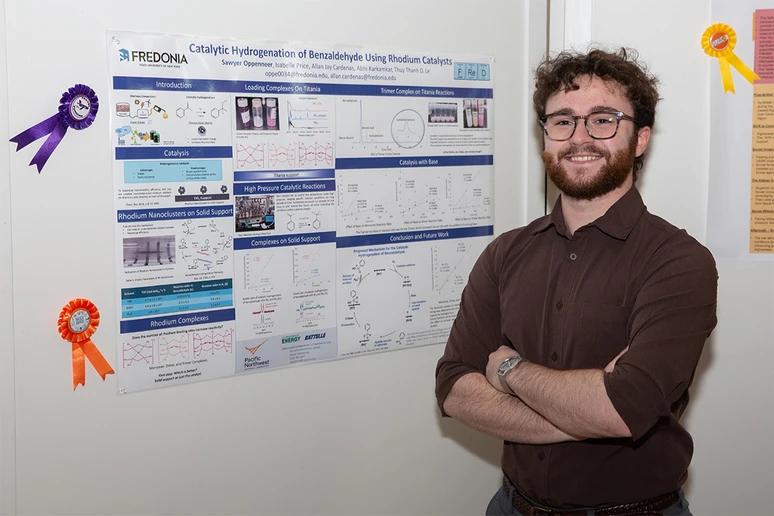

Sawyer Oppenneer, with his award-winning research poster.


Sawyer Oppenneer, with his award-winning research poster.
For Sawyer Oppenneer, good things come in threes: first place in Sigma XI poster competition and two nuclear science internships.
The junior Chemistry major from Saratoga Springs, NY, won first place for his poster presentation at the recent Sigma XI Undergraduate Research Conference held at Penn State Behrend, Erie, PA.
His poster, “Catalytic hydrogenation of Benzaldehyde using Rhodium Catalysts,” looked into determining the reaction mechanism and improving the overall efficiency of molecular rhodium catalysts in the hydrogenation of benzaldehyde as a model substrate. Mr. Oppenneer compiled this research last summer at the Pacific Northwest National Laboratory in Washington state.
Oppenneer has presented this research at several conferences, including the American Chemical Society Spring 2025 Conference in San Diego, CA.
The Sigma XI conference provides an opportunity for students to present their research and creative accomplishment results in a public setting, and many utilize the event to practice their presentations before presenting them in a national or international setting.
A year ago, Oppenneer, who has minors in Mathematics and Physics, was part of a SUNY Fredonia trio that won second place in the poster competition at the Sigma XI conference. He also gave an oral presentation of the project.
Oppenneer is believed to be the first SUNY Fredonia student accepted to internships for the Nuclear and Radiochemistry Summer School through the Department of Energy and the Nuclear Science Summer School at Michigan State University.
The Nuclear and Radiochemistry Summer School is a prestigious six-week program for undergraduates. One of just 24 students accepted to the program, Oppenneer has been assigned to the school’s west coast site at San Jose State University. The comprehensive program consists of lectures on the fundamentals of nuclear science, radiochemistry and their applications. Laboratory exercises include state-of-the-art instrumentation and technology used in basic and applied nuclear science and radiochemistry research and development.
Major themes of the program include environmental radiochemistry, nuclear energy, nuclear fuel reprocessing, nuclear security, actinide chemistry and nuclear medicine. Students will meet lecturers primarily from research universities, Department of Energy national laboratories and the government.
Attendees receive a stipend. Transportation, student housing, books and laboratory supplies are covered.
The second internship, to the Nuclear Science Summer School at Michigan State University, is a week-long program hosted by the Facility for Rare Isotope Beams, a laboratory at Michigan State. It includes a series of lecturers and activities that cover nuclear science and astrophysics. Current research topics and open questions in nuclear science are also explored.
Like the Nuclear and Radiochemistry Summer School, the Nuclear Science Summer School is limited to 24 students. There is no cost for undergraduates to attend and travel expenses are covered and lodging support is provided.
Oppenneer joined Associate Professor Allan Jay Cardenas’ research group during the spring semester of his first year at SUNY Fredonia, and credits Dr. Cardenas for his encouragement.
“Since then, he's supported me through my research and helped me gain valuable lab skills. He's pushed me to present my research at countless conferences,” Oppenneer said.
Oppenneer, who plans to attend graduate school to earn a Ph.D. in nuclear chemistry, wants to pursue research into the abnormalities in nuclear structure as nuclei have exotic neutron-proton ratios.
“All of my poster and oral presentations have and are preparing me to be able to professionally present and share my research, as well as providing invaluable opportunities to make connections with other researchers,” Oppenneer said.
Both internships, which Oppenneer refers to as his “magnum opus” at SUNY Fredonia, are directly positioned within the aspects of research he wants to pursue in graduate school. He plans to forge connections with professors who are a part of both programs and possibly shadow some of them or their current graduate students.
“These opportunities will hopefully set in stone my top graduate schools and if I can create strong connections, maybe help my chances of getting accepted into their Ph.D. programs, Oppenneer said.